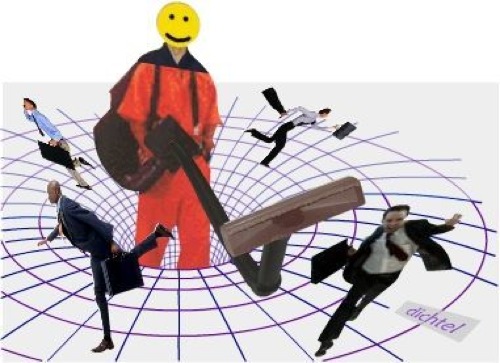DISRUPTIVE TECHNOLOGIES: IS LIBRARIANSHIP AS A CAREER A BENEFICIARY OR A VICTIM?
History is replete with lessons that few care to learn from
As a young boy, I used to enjoy visiting an Abattoir in my hometown. I would watch as the animals were led to meet a very grisly end to their lives. My mind would then wander to those animals in the waiting yard. None of them had a clue what was waiting ahead. They would be next as the queue got shorter with time. None of the animals had a choice but just wait and face it.
Whereas the animals in the waiting lot had no way out, we humans have one advantage. We can learn from those who have faced a demise and with thorough examination and redemptive actions can avoid falling victims. However, after watching a number of events that happen in the world around us, not all humans /organizations get to a point of learning from prevailing circumstances.
WHAT IS DISRUPTIVE TECHNOLOGY

Disruptive technologies means new technologies that still lack refinement, often have performance problems, are just known to a limited public, and might not yet have a proven practical application. Disruption is something that drastically alters or destroys the structure of society. Disruptive technologies hold within themselves the capacity to alter our lifestyle, what we mean by work, business, culture and the global economy
In 2011, the bookstore chain Borders was liquidated. In 2012, Kodak filed for bankruptcy. In 2013, Blockbuster went into administration. What do these businesses have in common? They all failed to respond sufficiently to disruptive technologies.
The world has always existed in a state of punctuated equilibrium: inventions and ideas shake up our reality, but before long we adjust to the new ‘normal’. Social, cultural and technological advancements move civilizations forward, but leave the ‘outmoded’ behind. Why use a sickle when you have a combine harvester? No one wants to stop the world turning, but what do you do if you are the person who makes sickles for a living?
The above companies did not die because they were idle. It was due to the target market moving with the times that were now influenced by the new technologies that these companies failed to adopt. Consequently, the companies went bankrupt, printing presses went idle, and jobs were lost.
WHICH OTHER INDUSTRIES HAVE BEEN DISRUPTED?
The list is endless in this case. In any case, almost every form of lifestyle has been disrupted by the changes in Information Technology. For instance, Postal mail has been disrupted by new technology. Post office Boxes now go for months without mails getting in there. Email can send messages over great distances and quickly, without the cost of a postage stamp and the whole hassle of visiting the post office to buy post and pick mail. Even email itself is facing obsolescence. Likewise, Kodak cameras using only film are relics now, as the film camera industry has been disrupted by digital imaging technology. And the list goes on. Technology disrupts an industry, shops are closed, and jobs are lost.
HAVE LIBRARIES BEEN SPARED?
The library industry is on the list of those disrupted by technological innovation. Not

too long ago, a typical librarian sat at a wooden desk, surrounded by thousands of hardcover books, some popular, others just on the shelves gathering dust. The traditional librarian was the shepherd of the books, tending and protecting them. People went to the library to borrow books, if they had a library card. And the traditional librarian would be available to help them. Take the case of a medical library: These libraries, located in or near a hospital, the medical librarian was not much different from other librarians. Medical librarians collected books and cataloged them, subscribed to journals and manually checked each issue into a log, and answered their customers’ questions using the books, journals, and printed indexes.
Innovation has hit this noble profession. Actually, it has hit hard with numerous disruptive technologies. The Internet search engine, social media, mobile telephony, electronic journals and books etc, are just but few of the many technologies that have disrupted traditional library work. Physical books and bound journals have disappeared from a number library collections. Librarians and end users alike search online databases for information on topics. At the same time, the number of users of physical libraries have decreased. They get their information online, offsite, at their work desk, at the point of care, and in the research labs. Libraries are closing, and jobs are lost.
FOR SOME LIBRARIES, INFORMATION IS MORE ACCESSIBLE THAN EVER BEFORE
In some libraries, disruption has been welcome with efforts to meet the challenges. It is an effort that goes beyond having networked computers with internet. The librarians that have managed tp beat the innovation disruption become recognized players in informatics. They have acquired the right skills to enable them to evaluate information systems, a semantic approach to scholarly networking, not just use them. They understand and participate in the data lifecycle. They can create gold standard search filters used to retrieve high-quality. They can devise a better way to evaluate the impact of scientific publications. They can survive and even increase services in spite of budget cuts. They can understand their users’ needs to create effective ways to get information to them.
The traditional roles of libraries are being challenged by disruptive technologies such as e-books, Amazon and social media. As fast information and to-the-door delivery become the norm, how do we ensure the continued validity of the library, etc…
EVOLVE OR FAIL: YOU CAN MAKE AN OPPORTUNITY OUT OF THIS
Everything discussed so far has a tone of inevitability. Time marches on, the wheel keeps turning and things will change. Yet there is only one thing inevitable about the fate of a disrupted sector: evolve or fail. The old adage that every challenge is both a threat and an opportunity is most true when it comes to business strategy.
NEED FOR AN APPROPRIATE RESPONSE
Disruptive technologies require a response: turn disruptions into competence-enhancing influences. This is easier said than done. Information Systems Professor Hank Lucas[2] of the Robert H. Smith School of Business at the University of Maryland, outlines the primary inhibiting factors that cause businesses (like Borders, Kodak and Blockbuster) to fail to react in a positive way to new technologies:
- Denial: ‘this will not affect us’

It is not going to happen to me as long as I don’t see it.
- History: ‘we have always done it this way’
- Resistance to change: ‘I don’t want to’
- Mindset: ‘but that is not what we do’
- Brand: ‘but that is not what we do’
- Sunk costs: ‘we are too financially invested in the traditional ways’
- Profitability: ‘we still have lots of customers… why change?’
- Lack of imagination: ‘there really is no other way for us to work’.
NEW IMAGINATIONS
One of the things you would give credit to librarians is their capacity to come up with new ways of doing things whenever under pressure. They are today coming up with new ways of utilizing digital technologies to enhance the library offer such as: e-book reading groups, online book battles, library Apps, augmented reality craft activities, QR Code trails, data fountains, YouTube book trailers, online database topic sharing, digital signage, digital book downloads, social media-based book shelves and gamification software – to name but a few.
With the correct attitude, it is not a case of ‘how can libraries survive’; it is a question of finding the best way to flourish
